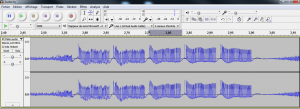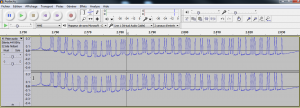In previous article, thanks to a R820T tuner, we managed to capture some RF4333 signal (which seems to be repeated 5 times).
Zooming in one pattern, we can see high and low bits.
Googling around, it appears that my di-o chacon telco is using the homeeasy protocol.
a preamble (before data) is HIGH for 275us and a LOW for 2675us.
a 0 is HIGH for 275us and LOW for 275us.
a 1 is HIGH for 275us and LOW for 1225us.
We therefore end up with 64 bits (wired):
01 01 01 10 10 10 01 10 01 10 01 01 10 01 01 10 10 10 10 01 10 10 10 10 10 01 01 10 01 01 01 01.
Still reading the homeeasy protocol, we learn than 01=0 and 10=1 (manchester encoding).
The result is (32 bits, decoded) :
00011101010010011110111110010000
Bit 0 to 25 is the device id : 11101010010011110111110 -> 7527BE
Bit 26 is the flag group : 0
Bit 27 is on/off : 1
Bit 28 to 31 is the device code : 0000
Now re using this article, we should be able to replay that signal with the right timings.


Hello friend, just discovered your blog and I am impressed with all projects.
A few months ago I started my career with Arduino, Raspberry Pi and home automation.
Currently I have an RPI with Jeedom software, Z-Wave equipment and rx-tx RFXtrx433E.
I have little idea of programming and everything I learn from what I read on the net.
The point is that I want to automate the heating. It is a wireless thermostat OTAX TPH05-0001TX make and model. 433,9Mhz working on frequency.
I want to replicate this thermostat signal which commands its corresponding receptor.
I caught the ON and OFF commands to the receiver with an XY-MK-5V receiver, sound card and Adobe Audition. Not how to make a sketch in Arduino and launch the signal with a transmitter 433Mhz FS1000A.
For more I read do not know how to program as I am an initiate.
If I can help you or someone read me, I attached a link to the WAV sound catches.
Thank you
https://drive.google.com/folderview?id=0B395WY0lF4x1bW9JN1FpUTJySWc&usp=sharing
you need to decode the wav file in a serie of 0 and 1’s.
[…] a previous article, we had managed to snif & record RF signals, decode it and reproduce it with […]